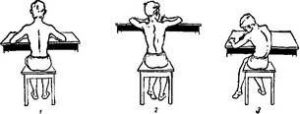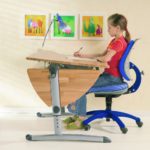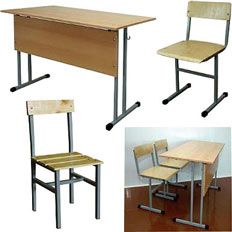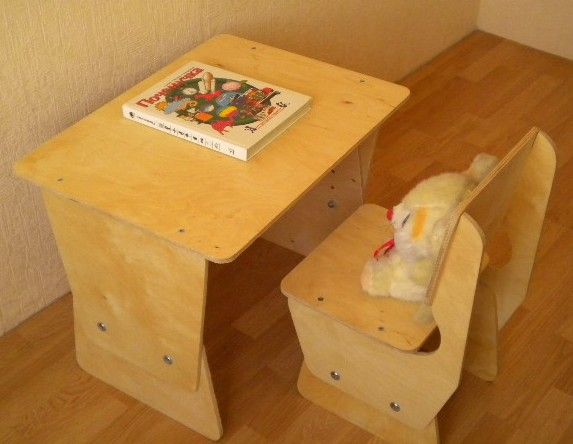How to sit at a desk correctly
 One of the most common health problems among schoolchildren is various posture disorders. With the beginning of education, the number of scoliosis in primary school students increases by 3.5-4 times. The number of posture disorders begins to increase from the first grade and gradually increases until the fifth grade. Then, by adolescence, it begins to decline. The habit of sitting at a table or desk in the correct position, as well as daily performance of a set of physical exercises to strengthen the back, will help give the spine the desired shape.
One of the most common health problems among schoolchildren is various posture disorders. With the beginning of education, the number of scoliosis in primary school students increases by 3.5-4 times. The number of posture disorders begins to increase from the first grade and gradually increases until the fifth grade. Then, by adolescence, it begins to decline. The habit of sitting at a table or desk in the correct position, as well as daily performance of a set of physical exercises to strengthen the back, will help give the spine the desired shape.
The content of the article
What is the correct position to sit at a desk?
The relevance of the problem is directly related to the organization of the child’s desk while performing tasks at home, as well as to the position at the desk while studying at school.
If the school where the child is studying has standard desks and there is no way to adjust them to the student’s height and build, then you can at least organize a suitable workspace at home. For example, it could be a transformable table and chair that are adjusted as the child grows actively.
Conditions to be followed:
- The height of the working surface should be approximately 2.5 centimeters above the elbow in a sitting position.
- During classes, the child should have several points of support: for the back, buttocks, upper and lower extremities.
- The back and hips form a 90 degree angle.
- Bent knees are at right angles, both elbows are on the table.
- The gap between the chest and the desk should be no more than two centimeters.
- The head is slightly tilted, the distance between the eyes and the notebook is about 30 centimeters.
Attention! In dim lighting, the child will be forced to lean towards the table, so the lamp should be bright enough.
How to learn to sit at a desk correctly
To position a student correctly at a desk or desk, it is necessary to develop the habit of automatically taking the desired position.
A few rules that your child needs to learn:
- When writing, you need to sit so that your body is in contact with the back of the chair.
- Shoulders should be straightened.
- The legs are placed on a support or on the floor with the entire surface of the soles.
- Both legs are placed on the floor, parallel to each other. Crossing your legs is not allowed.
- Hands are placed on the desk and do not support your head.
If you ignore these rules, the child's slouched back while sitting at the table will cause increased stress on the lumbar spine. Since the child spends a lot of time sitting, the incorrect position will become habitual and will lead to poor posture, the formation of scoliosis, skeletal deformation and other related diseases.
Important! Since the development of human posture begins in early childhood, it is necessary from elementary school to monitor how the student sits, stands and moves. This will help to notice the onset of deviations in time and prevent the formation of scoliosis.
Every 45 minutes while studying, you need to give your child a break. It is useful to perform various physical exercises at this time, which will give him the opportunity to warm up and relax his muscles.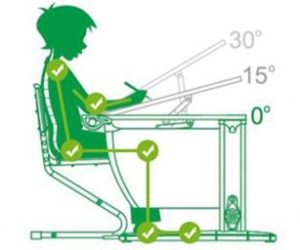
Useful exercises
The best prevention of back diseases is physical activity, daily walks and outdoor games. A regularly performed set of exercises will help to form correct posture and avoid spinal deformities:
Exercises:
- Stand against the wall so that your shoulder blades, buttocks, heels and the back of your head touch it. Hold the position for half a minute, then move away and stand in the same way, but without support for another half a minute.
- Lean on the wall so that your feet are located at a distance of about 40-50 cm from the wall. The muscles of the shoulders and back should be tense, the back as straight as possible. The shoulder blades, back of the head and lumbar region touch the surface of the wall. In this position, count to 4. Then relax your back and count to 4 again.
- Stand up straight with your hands on your waist. Tighten your back muscles, squeeze your shoulder blades together. The head is raised. Count to 4.
- Stand near the wall, spread your arms to the sides. Raise and lower your arms, making sliding movements along the surface of the wall.
- Take the starting position on the floor, rest your knees and palms on the floor. Raise your head, arch your back. Hold the position for 4 counts. Then lower your head down, rounding your back. Hold the position for another 4 counts.
- Lie on your back, bent legs resting on the floor, arms raised up. Tighten your back and straighten it. Hold the position for 4 counts.
- While lying on your stomach, straighten your body, raising your legs and head, hands on your belt. Take a breath. As you exhale, return to the starting position.
All exercises are repeated daily in three to four approaches. Optimally performed during morning exercises.
Reference! With correct posture, the child’s shoulders are on the same line and laid back, the shoulder blades are symmetrical.
Consequences of incorrect posture at a desk
If these rules are not followed and the seat at the desk is incorrect, various negative consequences are possible, for example:
- increased fatigue;
- low performance;
- instability of attention;
- circulatory disorders;
- breathing problems;
- herniated intervertebral discs;
- adhesions of muscle tissue;
- headaches and back pain.

The correct formation of posture depends on the child’s habits, upbringing, proper arrangement of the desktop and the opportunity to play sports.
During the process of active growth of a child, it is worth remembering that correct posture not only looks aesthetically attractive, but also contributes to the natural and healthy formation of internal organs.

